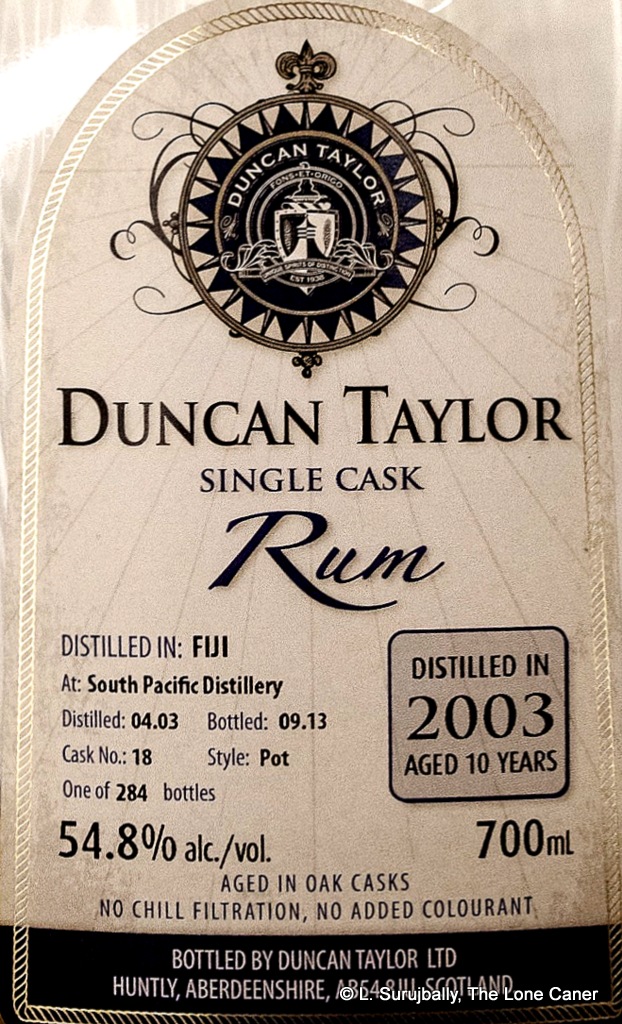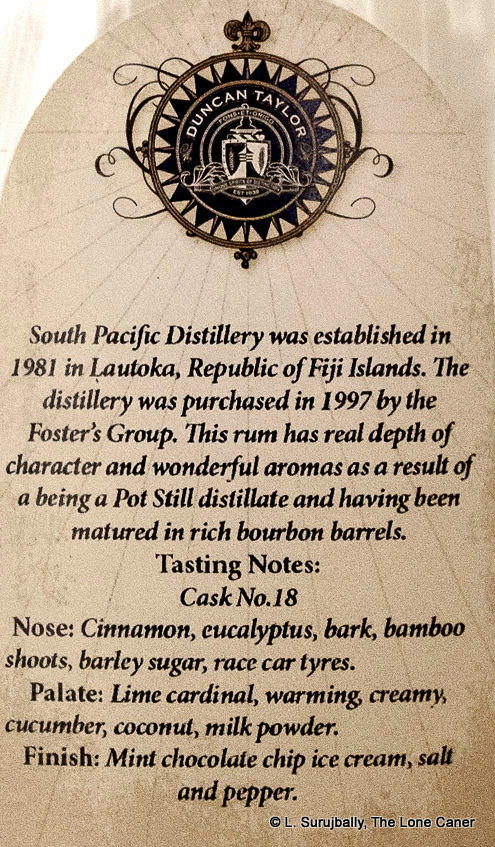
Nope, all apologies to the islanders, but Fiji still doesn’t ascend to the heights of a country whose rums we must have. Yet.
Let’s just dispense with two more Fijian products that crossed my path, provided by my friend Cornelius of Barrelproof, who, it should be noted upfront, liked them both a lot more than I did. We don’t see many products from that country anywhere – “Eastern” rums don’t make it west of the iron curtain very often, so it’s mostly in online emporia that we find find rums from Fiji, Australia, Indonesia or even Japan; these are sold primarily in Europe, not in North America. Bundie, Don Papa and Nine Leaves look to buck that trend but they are small potatoes, really, and you’re still gonna look hard to locate a Tanduay, or even the stuff out of India.
Anyway, independent bottlers Duncan Taylor, the Rum Cask, Compagnie des Indes, Berry Brothers and some others do take the single barrel route, and so perhaps we should be grateful that we do get the chance to try these unusual profiles whenever we can. The rum came from the same distillery as the BBR 8 year old and the Compagnie’s 10 year old: the Fijian South Pacific Distillery now owned by Fosters from Australia, and located in the northwest of the small island.

I said “unusual” a moment ago…it was not a word I chose lightly.
I poured the 54.8% hay-blonde, pot-still spirit into my glass, and flinched as if I had found a roach in my soup (oh waiter…!) Sharp, snarling smells of kerosene, sealing wax, floor polish emerged fast, like a pissed of genie out of his lamp, ungentle and clashing with each other in a most unbecoming fashion. I went back to the shelf and checked out the Clairin Sajous to see if it was me…nope, that was still better. Ten minutes rest period didn’t help much – turpentine, acetone, wet paint decided to come out now, joined by candle wax, green grape skins…and I was left thinking, if this was pot-still, unfiltered, and issued “as-was” from the barrel, maybe the barrel needed to be changed; and to be honest, if ever I tried a rum that made a strong case for either more ageing or some dosage, this was it. The smell was simply too raw and unrefined. Most of what it displayed was liquid sandpaper only marginally improved by some ageing.
To my relief, there was some compensation once I tasted the thing. Better, much better. Heated and very spicy, medium bodied in texture, and all this was a welcome change from the initial attack. It tasted of red olives in brine, with a sort of meaty background, like a plastic tub of salt beef just starting to go. Then at last more familiar notes asserted themselves and stopped mucking about, and I sensed some green grapes just starting to go, vanilla and smoke (not much), a very herbal, grassy element, more brine, sweet soya, some citrus, ginger and a good Thai veggie soup. Cornelius felt it displayed something the funky charm of the Jamaican style, so if you ever get around to trying it yourself, there would be something to watch out for. The finish, unsurprisingly for such strength, was long enough, and I couldn’t say it was either good or bad – it existed, it lasted, I got notes of lemongrass, vanilla, citrus and soya and brine again, but very little of a more comforting back end. Colour me unimpressed, sorry.
Although the aromas and tastes suggest a cane juice base distillate, the Ministry of Rum and Fiji Rum Co. pages both say molasses. Which makes the profile I describe even odder, because it was so much like the clairins, but lacking their fierce commingling of the same tastes into a synthesis that worked. The nose was too jagged and too raw, the palate worked (up to a point) and the finish was nothing to write home about. In my opinion, this rum should have been left to sleep some more. The outturn was 284 bottles from a single cask, and it was aged in an oak cask for ten years, yet honestly, you might think it was no more than a three year old (or even younger) from the way it fended off any efforts to come to grips with it.

I’ve now tried four or five Fijian rums, and admittedly, that’s hardly a huge sample set; still they do all exhibit a kind of right turn from reality that takes some getting used to, for those of us more accustomed to Caribbean traditionals or agricoles (which is most of us). They may be proof positive that terroire is no mere subtly abstract concept which is insouciantly bandied about but lacking real meaning, and I believe that rums from other parts of the world do indeed provide their own unique tastes and smells and sensations. The flip side of that, is that I have yet to acquire a real taste for some of them. I’m not going to write Fijians off like yesterday’s fish…but thus far I haven’t met any (out of the few I’ve tried) that blow my socks off either. Certainly this rum doesn’t.
(#253. 81/100)
Other notes
- Aged April 2003 to September 2013, location unknown
- Yes, if I see more Fijians, I’ll buy. Still really curious about them.
- Marco Freyr has put together a short bio of the company (in German)
- The tasting notes above are my own. I didn’t see the back label until Cornelius kindly sent me some pictures of the bottle.
I have yet to try out Fijian rums but maybe it`s a lot about what you use them for in this case….because they have been highly praised by tiki bartenders and that`s what picked my intererest in trying some out. Apparently they are supposed to have a very strong and pungent flavor profile fit for tiki drinks…or so I hear…
Hi Tiare
Your point is valid…I suspect that what various bartenders describe as pungent, is that whiff of Jamaican funk Cornelius mentioned (which I didn’t get). On a sipping level, it doesn’t work for me. I hope others will weigh in with their own experiences over time.
An idea that supports the bartenders contention that this is a great rum for tiki drinks, is the fact that a really good top-end rum is tough to make a mixed drink with, because it already stands so well by itself and can’t always be enhanced (I stand ready to be corrected by you or Josh on this). But something a bit more raw and unrefined and with odd tastes exploding in all directions, is tailor made for such additions and mixings, because just about anything you do to it will improve it.
I also have tried a Fiji rum. It was from a different bottler (The Rum Cask), but it was also 10 years old and from 2003, so I guess that it is comparable with the reviewed one.
I also found it to be very Jamaican in style, it had similarities to both a 1993 Long Pond (a somewhat pungent fruitiness) and a 2000 Hampden (meaty/savory notes, especially with water), that I had tried before.
I liked the Fijan quite a bit, not as much as the Jamaicans though. And since all Fiji rums on the market come from the same distillery (I think there is only one ?) and are quite young (all roughly around 10 years old) i feel no need to buy another one. But perhaps we are in for a pleasant surprise in a few years, when the first older bottlings appear.
I’m looking at the Rum Cask Fiji next week. There, the Jamaican influences were more marked, and I liked it a smidgen more. But my feeling is still that until Fijian rums – all from South Pacific Distillery thus far – up the ante, they will continue to lag in my appreciation. They’re just don’t seem as well put together as true Jamaicans.
The only Fiji rum I tried so far is the Samaroli Fiji Rum from 2001 (12y old). I was very skeptical at first and was not immediately convinced, but found it tasted better every weekend. After 6 weeks the turpentine is at an acceptable level and I find myself actually being quite fond of it now. Not sure if I just got used to it or if the aggressiveness is just out the bottle.
I was told (in a whisky shop) that the Fiji rum is one that appeals to Whisky drinkers.